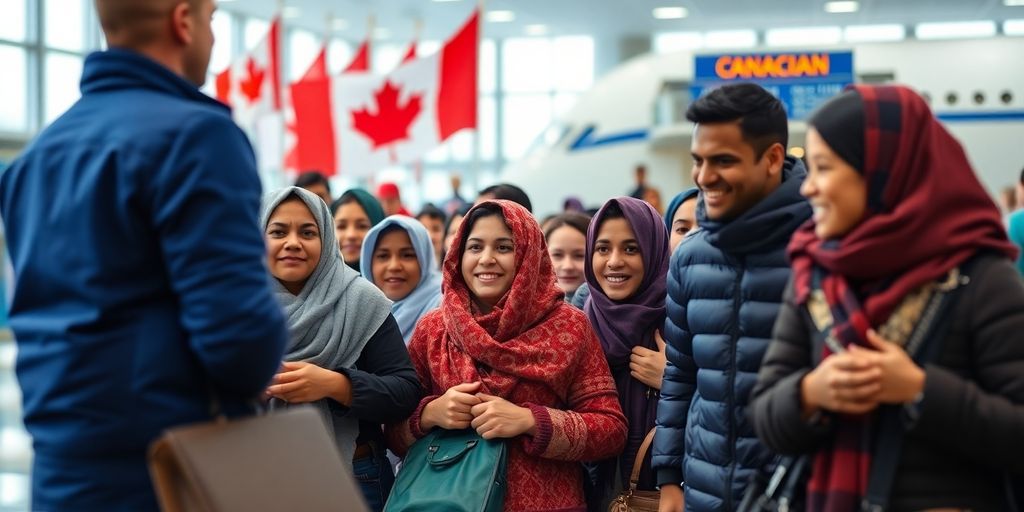Canada has long been seen as a safe haven for those seeking refuge from conflict, persecution, and hardship. However, recent events have raised questions about the fairness and consistency of its refugee admission policies. Are some groups favored over others? This article explores the complexities of Canada’s refugee acceptance inconsistency, examining historical context, public opinion, and the impact of global crises.
Key Takeaways
- Canada’s refugee policies have evolved significantly over the years, influenced by historical events and changing public attitudes.
- Recent conflicts, such as those in Sudan and Ukraine, have highlighted disparities in how Canada welcomes refugees from different regions.
- The asylum process in Canada presents many challenges for newcomers, including legal hurdles and lengthy wait times.
- Public opinion plays a crucial role in shaping refugee policies, with media portrayal often swaying perceptions of asylum seekers.
- Institutional biases may affect the treatment of certain refugee groups, raising concerns about equity in Canada’s immigration system.
Understanding Canada’s Refugee Acceptance Inconsistency
Historical Context of Refugee Policies
Looking back, Canada’s approach to refugees has changed a lot. Early policies were often shaped by the needs of the labor market and, let’s be honest, some pretty biased ideas about who would "fit in" best. Over time, we’ve seen shifts toward a more humanitarian focus, especially after major global events. But even with these changes, the past leaves a mark on how things are done today. It’s like trying to renovate a really old house – you can’t ignore the original structure, no matter how much you want to.
Recent Changes in Immigration Laws
Canada’s immigration laws are updated all the time, and these changes can really shake things up for refugees. Sometimes, the rules get stricter, making it harder for people to get in. Other times, there are efforts to make the system faster or more fair. For example, the government might introduce new categories for certain types of refugees or change the requirements for sponsorship. Keeping up with these changes is like trying to follow a recipe that keeps getting rewritten mid-bake.
Public Perception of Refugee Admissions
What people think about refugees has a big impact on policy. If the public is generally supportive, the government might be more willing to accept more refugees. But if there’s a lot of fear or negativity, things can get tough. Media coverage, political talk, and even just everyday conversations can shape these views. It’s a bit of a feedback loop: public opinion influences policy, and policy, in turn, can influence public opinion.
It’s important to remember that behind every statistic, there’s a person with a story. Understanding the human side of refugee admissions can help us have more thoughtful conversations about policy.
The Impact of Global Crises on Refugee Admissions
Global crises act as major catalysts, significantly shaping refugee admissions worldwide. The urgency and scale of these events often force nations, including Canada, to reassess their immigration policies and humanitarian commitments. It’s a complex interplay of need, capacity, and political will.
Current Conflicts Driving Asylum Seekers
The world is, sadly, never short of conflict. Right now, several ongoing crises are forcing people to flee their homes and seek asylum elsewhere. The war in Ukraine, for example, has created a massive displacement crisis, with millions seeking refuge in neighboring countries and beyond. Similarly, ongoing instability in parts of Africa and the Middle East continues to generate significant numbers of asylum seekers. These situations put immense pressure on countries like Canada to respond. The sad reality is that the sheer volume of people needing help can be overwhelming. It’s not just about war, either; climate change is increasingly becoming a driver of displacement, forcing people to leave their homes due to natural disasters and environmental degradation.
Comparative Analysis of Refugee Influx
It’s interesting to look at how different crises lead to different responses. For example, the influx of Syrian refugees in 2015 saw a significant outpouring of support and a relatively streamlined immigration process in Canada. In contrast, responses to refugees from other regions, like Afghanistan, have sometimes been slower and faced more hurdles. This raises questions about equity and consistency in our approach. A comparative analysis reveals that factors like public perception, political considerations, and existing diplomatic relations can all play a role in shaping how Canada responds to different refugee crises. It’s not always a straightforward humanitarian calculation.
Canada’s Response to Global Displacement
Canada’s response to global displacement is multifaceted, involving government initiatives, private sponsorships, and the work of numerous NGOs. The country has a long history of welcoming refugees, but the scale of recent crises has tested its capacity and resources. Canada’s approach often involves setting refugee quotas, prioritizing certain groups based on vulnerability, and providing financial and settlement support to newcomers. However, challenges remain, including long processing times, housing shortages, and difficulties in integrating into the labor market. It’s a constant balancing act between providing humanitarian assistance and managing the practical realities of integrating large numbers of people into Canadian society.
Canada’s response to global displacement is a complex issue with many layers. It involves not only providing immediate assistance but also addressing the long-term needs of refugees and ensuring their successful integration into Canadian society. This requires a coordinated effort from government, NGOs, and the community as a whole.
Here are some key aspects of Canada’s response:
- Setting annual refugee quotas.
- Providing financial assistance to refugees.
- Offering settlement services, including language training and job search assistance.
- Partnering with NGOs to provide support and advocacy.
Examining Canada’s Asylum Process
The Journey of Asylum Seekers
When people arrive in Canada seeking asylum, the process they face is often complex and filled with uncertainty. It starts with making a claim, usually at a port of entry or an inland office. After this initial step, there’s an eligibility assessment. If the claim is deemed eligible, it’s then referred to the Immigration and Refugee Board of Canada (IRB) for a hearing. The IRB is an independent tribunal that decides on refugee claims. The whole process can take a while, and it’s not uncommon for people to feel lost or overwhelmed. In the first nine months of 2024, nearly 14,000 international students sought refugee status in Canada, a significant increase from just 1,810 in 2018.
Challenges Faced by Refugees
Refugees encounter numerous hurdles throughout the asylum process. Language barriers can make it hard to understand the legal requirements and communicate effectively with officials. Finding adequate housing and employment is another big challenge, especially in cities with high living costs. Access to healthcare and social services is also essential, but not always easy to obtain. The emotional toll of leaving one’s home and facing an uncertain future can be immense.
- Language barriers
- Housing and employment
- Access to healthcare
Many asylum seekers arrive with very little, having left behind everything they know. The challenges they face in adapting to a new country, navigating the legal system, and rebuilding their lives are significant and require a compassionate and supportive approach.
Legal Framework Governing Asylum
Canada’s asylum system is governed by the Immigration and Refugee Protection Act (IRPA). This law sets out the criteria for determining who qualifies as a refugee and the procedures for making a claim. The Safe Third Country Agreement with the U.S. also plays a role, as it generally requires asylum seekers to make their claim in the first safe country they arrive in. However, there are exceptions to this rule. Ottawa is planning to propose new asylum rules to allow for faster deportations. Understanding the legal framework is key to understanding how the system works, even though it can be quite complicated.
The Role of Public Opinion in Refugee Policy
Shifting Attitudes Towards Refugees
Public opinion plays a big role in shaping refugee policy. It’s not just about what the government thinks; it’s about what we think. And those thoughts? They change. Sometimes, there’s a lot of support for refugees, especially when there’s a big crisis happening somewhere. Other times, when things feel tough at home, people might be less welcoming. It’s a complicated mix of empathy, fear, and economic worries. Understanding these shifts is key to understanding why Canada’s refugee policies sometimes seem inconsistent. According to May 2023 data, a significant portion of Canadians believed refugees positively contributed to the country.
Media Influence on Public Perception
The media has a huge impact. The stories they tell, the images they show – they all shape how we see refugees. If the news focuses on the challenges that refugees face, or the contributions they make, it can create a more positive view. But if the focus is on negative stories, it can lead to fear and mistrust. It’s not always a conscious thing, but the media definitely influences the conversation. It’s important to think critically about what we’re seeing and reading, and to seek out different perspectives.
Community Support for Refugees
It’s easy to get caught up in the big picture, but it’s important to remember that refugee policy also affects local communities. When communities are welcoming and supportive, refugees have a much better chance of integrating and thriving. This support can come in many forms, from volunteer work to donations to simply offering a friendly face.
Local initiatives are often the unsung heroes in refugee integration. They provide essential services, build bridges between cultures, and create a sense of belonging. These efforts are vital for ensuring that refugees not only survive but also thrive in their new homes.
Here are some ways communities can support refugees:
- Offering language classes
- Providing job training and placement assistance
- Organizing cultural events to promote understanding
- Mentoring refugee families
Ultimately, public opinion is a powerful force that shapes refugee policy. By understanding the factors that influence public perception, we can work towards creating a more welcoming and equitable system for refugees in Canada.
Institutional Racism and Refugee Admissions
Disparities in Treatment of Refugee Groups
It’s hard to ignore the feeling that some refugee groups get a warmer welcome than others. I think a big part of this comes down to institutional biases, whether we like to admit it or not. It’s not always overt, but it shows up in processing times, the level of support offered, and even the way their stories are portrayed in the media. These subtle differences can have a huge impact on people’s lives.
Case Studies of Afghan and Ukrainian Refugees
Looking at how Canada responded to the crises in Afghanistan and Ukraine offers a pretty stark contrast. While there was a huge outpouring of support and streamlined processes for Ukrainian refugees, the situation for Afghans felt much slower and more complicated. I’ve noticed that the speed of processing applications and the resources allocated seemed to vary quite a bit. It makes you wonder why. The IRCC is implementing anti-racism initiatives to address these disparities.
Advocacy for Equitable Policies
If we want a truly fair system, we need to push for policies that treat all refugees with the same level of respect and urgency. This means:
- Demanding transparency in how refugee claims are processed.
- Ensuring equal access to resources and support services.
- Challenging biased narratives in the media.
It’s about holding our government accountable and making sure that our refugee policies reflect our values of equality and compassion. We need to move beyond lip service and create real, lasting change. The current refugee sponsorship programs need to be re-evaluated to ensure fairness.
Ultimately, it’s about recognizing that everyone deserves a fair chance, no matter where they come from or what they’ve been through.
Political Factors Influencing Refugee Acceptance
Government Priorities and Refugee Quotas
As someone observing Canada’s refugee policies, it’s clear that government priorities play a big role. The number of refugees Canada accepts isn’t just about humanitarian needs; it’s also tied to what the government wants to achieve politically and economically. For example, if the government is focused on filling labor shortages, they might prioritize refugees with skills that are in demand. This can lead to some groups being favored over others, regardless of their level of need. Refugee quotas are often adjusted based on these priorities, which can change with each new administration. It’s a balancing act between international obligations, domestic needs, and political considerations.
Impact of International Relations
Canada’s relationships with other countries also influence who gets accepted as a refugee. If Canada has a strong alliance with a particular country, it might be more willing to take in refugees from there. Conversely, if relations are strained, it could be harder for people from that country to get asylum. International agreements and diplomatic pressures can also shape Canada’s refugee policies. For instance, commitments to international organizations like the UN can influence the number of refugees Canada agrees to resettle each year. It’s a complex web of factors that go beyond just helping those in need.
Political Rhetoric and Its Consequences
The way politicians talk about refugees can have a huge impact on public opinion and, ultimately, on refugee policies. Positive rhetoric can create a welcoming environment and encourage support for increased refugee admissions. On the other hand, negative rhetoric can fuel fear and resentment, leading to stricter policies and reduced acceptance rates. It’s important to remember that words matter, and the language used by political leaders can shape the lives of vulnerable people seeking safety in Canada. The religious persecution claims are often influenced by the political climate in their home countries.
Political rhetoric can also affect the integration process for refugees who are already in Canada. If refugees are portrayed negatively, it can lead to discrimination and make it harder for them to find jobs, housing, and social support.
Here are some ways political rhetoric can affect refugee policies:
- Shaping public opinion
- Influencing policy decisions
- Impacting refugee integration
The Humanitarian Perspective on Refugee Policies
Ethical Considerations in Refugee Admissions
When we talk about refugee policies, it’s easy to get lost in the numbers and legal jargon. But at its core, this is about people – individuals and families fleeing unimaginable circumstances. I believe it’s vital to remember the human element in every decision. Are we truly doing everything we can to offer safety and a chance at a new life? It’s a question I often ask myself. The ethical implications of who we choose to help, and how we help them, should always be at the forefront of the discussion.
Voices of Refugees: Personal Stories
Statistics can be impersonal. To truly understand the impact of refugee policies, we need to listen to the stories of those who have experienced displacement firsthand. These narratives offer a window into the challenges, hopes, and resilience of refugees. I’ve found that hearing these personal accounts can be incredibly moving and can reshape our understanding of the issues at hand. It’s about putting a face to the numbers and recognizing the shared humanity that connects us all. I think it’s important to consider the refugee status in Canada and how it affects people’s lives.
The Role of NGOs in Advocacy
Non-governmental organizations (NGOs) play a vital role in advocating for refugee rights and providing essential support to those seeking asylum. These organizations often work on the front lines, offering everything from legal assistance to basic necessities. I see them as a crucial bridge between refugees and the systems designed to help them. Their advocacy efforts help to shape public opinion and influence policy decisions. They are a voice for the voiceless, and their work is essential to ensuring that refugees are treated with dignity and respect.
It’s easy to feel overwhelmed by the scale of the global refugee crisis. But I believe that even small acts of kindness and support can make a difference in the lives of individuals and families seeking safety. Whether it’s volunteering time, donating to organizations that support refugees, or simply speaking out in support of humane policies, we all have a role to play in creating a more welcoming and just world.
Here are some ways NGOs help:
- Providing legal aid.
- Offering language training.
- Assisting with housing and employment.
Canada’s Refugee Sponsorship Programs
Community Sponsorship Initiatives
Canada’s community sponsorship programs are a pretty big deal. They let groups of regular citizens get together and directly support refugees coming into the country. It’s not just about money; it’s about helping people get settled, find jobs, and learn the language. These initiatives really show how communities can step up and make a real difference in someone’s life.
- Providing initial housing and basic necessities.
- Assisting with language training and cultural orientation.
- Helping refugees find employment opportunities.
Challenges in the Sponsorship Process
Okay, so it’s not all sunshine and rainbows. There are definitely some bumps in the road when it comes to sponsoring refugees. Paperwork can be a nightmare, and it can take a long time to get everything approved. Plus, sponsors need to have a solid plan and enough resources to support the refugees they’re bringing in. Financial strain is a big concern for many groups.
The biggest challenge I’ve seen is the sheer amount of time it takes. From the initial application to the actual arrival of the refugees, it can be a really long wait. This can be tough on both the sponsors and the refugees, who are often living in uncertain conditions while they wait.
Success Stories from Sponsorship Programs
Despite the challenges, there are tons of amazing success stories out there. I’ve heard about refugees who’ve started their own businesses, gone back to school, and become active members of their communities. It’s incredibly rewarding to see how these programs can help people rebuild their lives and contribute to Canada. These stories highlight the positive impact of community involvement.
| Success Metric | Example |
|---|---|
| Employment Rate | 85% of sponsored refugees find employment within two years. |
| Educational Attainment | 40% pursue further education or vocational training. |
| Community Involvement | 90% participate in local events and volunteer activities. |
Future Directions for Canada’s Refugee Policy
Proposed Reforms to Improve Consistency
As I see it, Canada’s refugee policy needs a serious update. We need to look at ways to make the system fairer and more consistent. Right now, it feels like some groups get preferential treatment, and that’s not right. One key reform would be to establish clearer, more objective criteria for refugee acceptance, reducing the potential for bias. I think we should consider:
- Implementing a points-based system that prioritizes factors like vulnerability and persecution risk.
- Increasing transparency in decision-making processes.
- Providing better training for immigration officers on cultural sensitivity and trauma-informed practices.
The Role of Technology in Refugee Processing
Technology could really change how we handle refugee claims. Imagine using AI to help process applications faster or to identify individuals at risk. Technology can help, but we need to be careful about privacy and security. I think we should explore:
- Using AI to translate documents and streamline communication.
- Implementing secure online portals for applicants to track their cases.
- Developing data analytics tools to identify trends and patterns in refugee flows.
Long-term Solutions for Refugee Integration
Bringing refugees to Canada is just the first step. We need to think about how to help them build new lives here. This means providing access to language training, job opportunities, and social support networks. It’s not just about giving people a place to live; it’s about helping them thrive. I believe that:
- Investing in language training programs tailored to refugees’ needs.
- Creating mentorship programs that connect refugees with established community members.
- Providing funding for community organizations that offer settlement services.
It’s important to remember that refugees are not just numbers; they are people with skills, experiences, and dreams. By investing in their integration, we can create a more welcoming and prosperous society for everyone.
Final Thoughts on Canada’s Refugee Policies
In the end, Canada’s approach to refugee admissions raises some tough questions. While many see the country as a beacon of hope, the reality is more complicated. The disparity in how different groups are treated can feel unfair, especially when you look at the numbers. As more people seek safety here, it’s clear that Canada needs to step up and address these inconsistencies. It’s not just about numbers; it’s about lives. Every refugee has a story, and they deserve a fair chance. Moving forward, Canada has an opportunity to show true leadership in humanitarian efforts, but it will take a commitment to fairness and equity for all.
Frequently Asked Questions
Why are so many asylum seekers coming to Canada?
Last year, about 40,000 people crossed into Canada from the U.S. to ask for asylum. Many believe Canada is more welcoming than the U.S. However, there are concerns about whether Canada can manage this large number of arrivals.
What factors are affecting refugee admissions in Canada?
Current global conflicts, like those in Sudan and Ukraine, are pushing more people to seek refuge. However, Canada has admitted fewer refugees from some crises than others, leading to claims of unfair treatment.
What is the asylum process like in Canada?
The journey for asylum seekers in Canada can be long and complicated. They face many challenges, including legal hurdles and the stress of uncertainty about their future.
How does public opinion shape Canada’s refugee policies?
Public attitudes towards refugees are changing. The media plays a big role in shaping how people view refugees, and community support can greatly impact the acceptance of newcomers.
Is there racism in Canada’s refugee admissions?
Some argue that there is unequal treatment of different groups of refugees, with claims that Afghan refugees are not treated the same way as Ukrainian refugees. This raises concerns about institutional racism.
How do political factors influence refugee acceptance?
Government priorities and international relations can affect how many refugees Canada accepts. Political speeches and actions can also shape public opinion and policy.
What ethical issues are involved in refugee admissions?
There are important moral questions about how Canada treats refugees. Listening to the personal stories of refugees can highlight the human side of these policies.
What does the future hold for Canada’s refugee policy?
There are suggestions for reforms to make the refugee process fairer and more efficient. Technology may also play a role in improving how refugees are processed and integrated into Canadian society.










